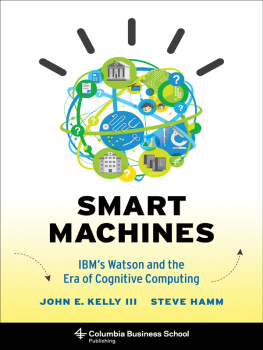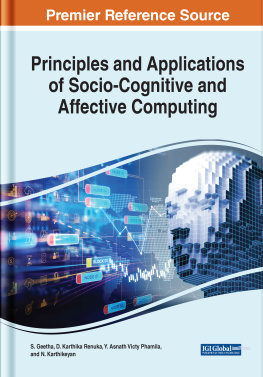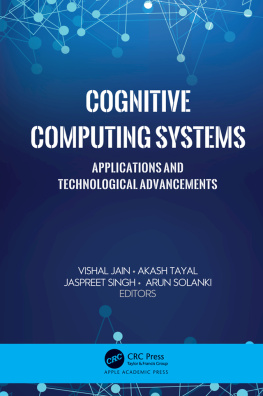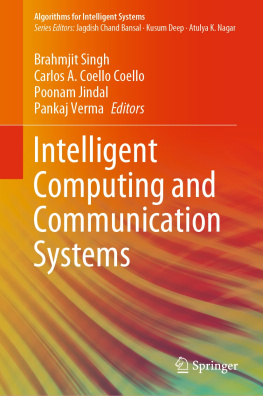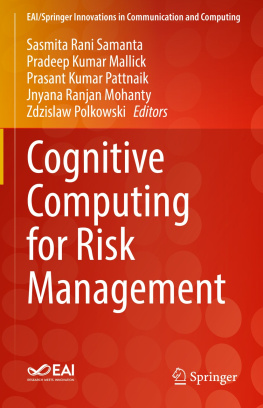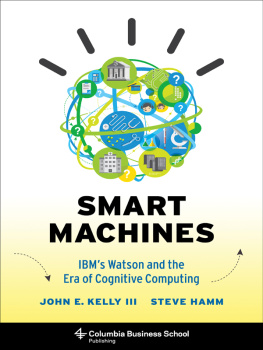SMART MACHINES
SMART MACHINES
 | IBMs Watson and the Era of Cognitive Computing |  |
JOHN E. KELLY III STEVE HAMM
| Columbia Business School Publishing |
COLUMBIA UNIVERSITY PRESS
Publishers Since 1893
New York Chichester, West Sussex
cup.columbia.edu
Copyright 2013 IBM Corporation
All rights reserved
E-ISBN 978-0-231-53727-8
Library of Congress Cataloging-in-Publication Data
Kelly, John E., III (John Edward), 1954
IBMs Watson and the era of cognitive computing / John E. Kelly III and Steve Hamm.
pages cm
Includes bibliographical references.
ISBN 978-0-231-16856-4 (cloth : alk. paper) ISBN 978-0-231-53727-8 (e-book)
1. Expert systems (computer science) 2. Artificial intelligence. 3. Watson (Computer) I. Hamm, Steve. II. Title.
QA76.76.E95K434 2014
006.3'3dc23
2013026154
A Columbia University Press E-book.
CUP would be pleased to hear about your reading experience with this e-book at .
Cover illustration: Courtesy of International Business Machine Corporation, International Business Machines Corporation
Cover design: Lisa Hamm
References to websites (URLs) were accurate at the time of writing. Neither the author nor Columbia University Press is responsible for URLs that may have expired or changed since the manuscript was prepared.
CONTENTS
John E. Kelly III
W hen I was a kid, my dad worked at General Electrics R&D lab in Niskayuna, N.Y. I would visit and watch him work with vacuum tubes, which looked like lightbulbs and directed electrical current in all sorts of devices, from radios and TVs to radar and computers. At the time, I didnt fully understand how vacuum tubes worked, but those visits inspired me to study science and, ultimately, to get two degrees in physics and my Ph.D. in materials engineering. I later came to realize that I had witnessed one of the important transitions in the history of technology. While my dad was showing me vacuum tubes, other engineers were experimenting with the vacuum tubes successor, the transistor, which ultimately ushered in modern electronics and personal computing.
Now we are at the dawn of a much bigger shift in the evolution of technologya new era affecting nearly every aspect of the field. The changes that are coming over the next two decades will transform the way we live and work just as the computing revolution has transformed the human landscape over the past half century. At IBM, we call this the era of cognitive computing.
I have had the pleasure of participating in the march of progress in computer science since I joined IBM in 1980 as an engineer. Ive led organizations that contributed major breakthroughs in science and technology, including the companys microelectronics division and, presently, IBM Research, one of the most extensive corporate scientific-research organizations in the world, with 3,000 scientists and engineers at 12 labs in 10 countries.
Today, society is faced with a host of opportunities and challenges that require a new generation of technologies and a rewriting of the rules of computing. The availability of huge amounts of data should help people to better understand complex situations. In reality, though, more data often lead to more confusion. We make too many decisions with irrelevant or incorrect information, or with data that represent only part of the picture. We need a new generation of toolscognitive technologiesthat help us to penetrate complexity and comprehend the world around us so that we can make better decisions and live more successfully and sustainably. Yet some of the techniques of computer science and engineering are reaching their limits. The technology industry must change the way it designs and uses computers and software if it is to continue to make progress in how people work and live.
The vision of the future of information technology presented in this brief book is the result of a large group effort. Several years ago, I asked a handful of IBM scientists to look decades into the future and sketch out how computing will change. Their work sparked discussions and debates among a wide range of IBMers, including the companys top executives, which, ultimately, evolved into a shared belief about the future of computing.
We want to expose our thoughts to others and engage in a conversation, so I asked Steve Hamm, a former journalist who is now a writer at IBM, to help lay out our vision in this book. Steve has been writing and editing stories about the tech industry for nearly twenty-five years and has witnessed the beginnings of several waves of innovation. For instance, in 1994 he visited the founding engineers of Mosaic Communications (later to be renamed Netscape) shortly after they set up shop in a tiny office on Castro Street in Mountain View, Calif. That was the dawn of the Internet era. Since then he has written hundreds of stories about innovation. In addition, he has authored books about the rise of the Indian tech industry, mobile computing, and the future of work. With that kind of deep experience, Steves a natural partner for me in this project. He interviewed dozens of IBMs scientists and engineers plus numerous outside experts to flesh out the vision and shape the narrative.
The creation of this new era of computing is a monumental endeavor, and, while IBM possesses a vision of the future and a broad portfolio of expertise, no company can take on this sort of challenge alone. So we look to our clients, university researchers, government policy makers, industry partners, and entrepreneursindeed, the entire tech industryto take this journey with us. Already, other companies, such as Google and Microsoft, are carving out roles in the era of cognitive computing. The European Union, with its Human Brain Project, is coordinating cognitive scientists worldwide in an effort to map the inner workings of the brain and mimic them in computing. Among the leading universities in the field are MIT, Carnegie Mellon, and Stanford. Many other organizations are also in the game.
With this book, which is aimed at a broad audience rather than just the technical community, we hope to greatly expand the search for answers by stimulating new thinking within industry, government, and academia. And, just as importantly, we hope to inspire university and high school students to pursue careers in science, technology, engineering, and mathematics. Together, we can drive the exploration and invention that will shape society, the economy, and business for the next fifty years.

I BMs Watson computer created a sensation when it bested two past grand champions on the TV quiz show Jeopardy! Tens of millions of people suddenly understood how smart a computer could be. This was no mere parlor trick; the scientists who designed Watson built upon decades of research in the fields of artificial intelligence and natural-language processing and produced a series of breakthroughs. Their ingenuity made it possible for a system to excel at a game that requires both encyclopedic knowledge and lightning-quick recall. In preparation for the match, the machine ingested millions of pages of information. On the TV show, first broadcast in February 2011, the system was able to search that vast storehouse in response to questions, size up its confidence level, and, when sufficiently confident, beat the humans to the buzzer. After more than five years of intense research and development, a core team of about twenty scientists had made a very public breakthrough. They demonstrated that a computing systemusing traditional strengths and overcoming assumed limitationscould beat expert humans in a complex question-and-answer competition using natural language.

